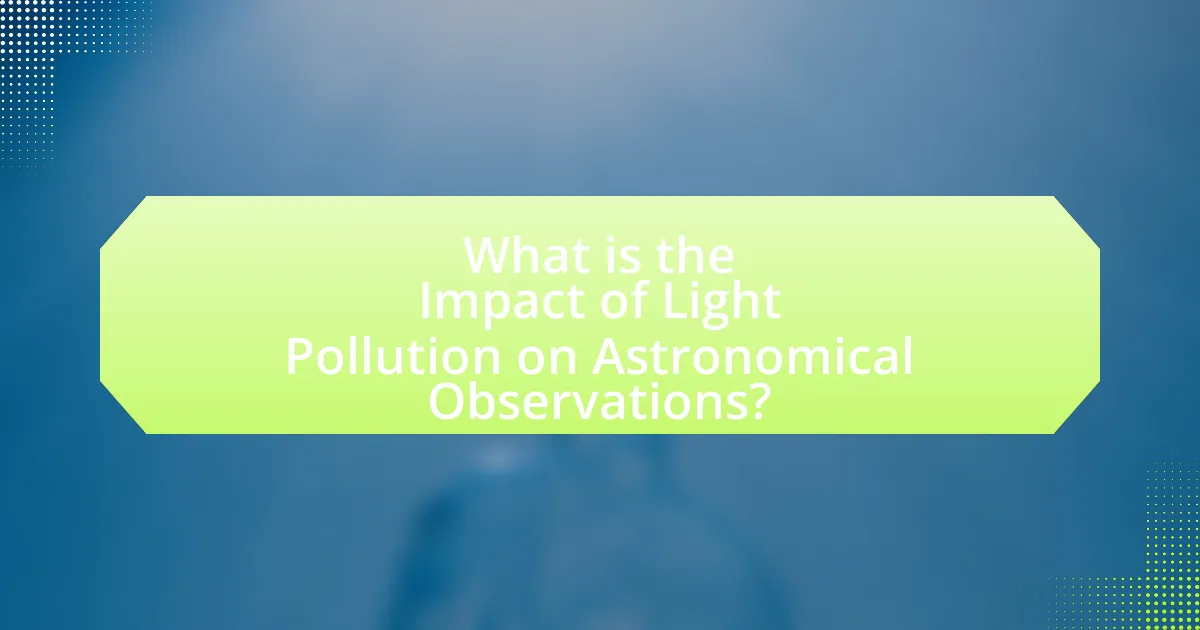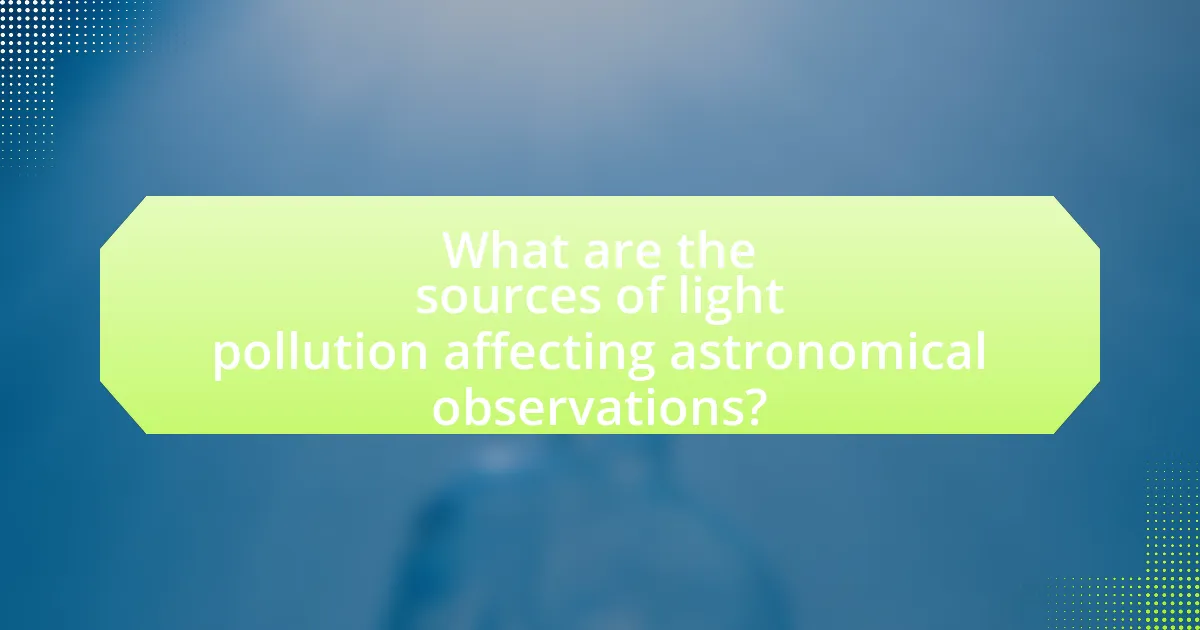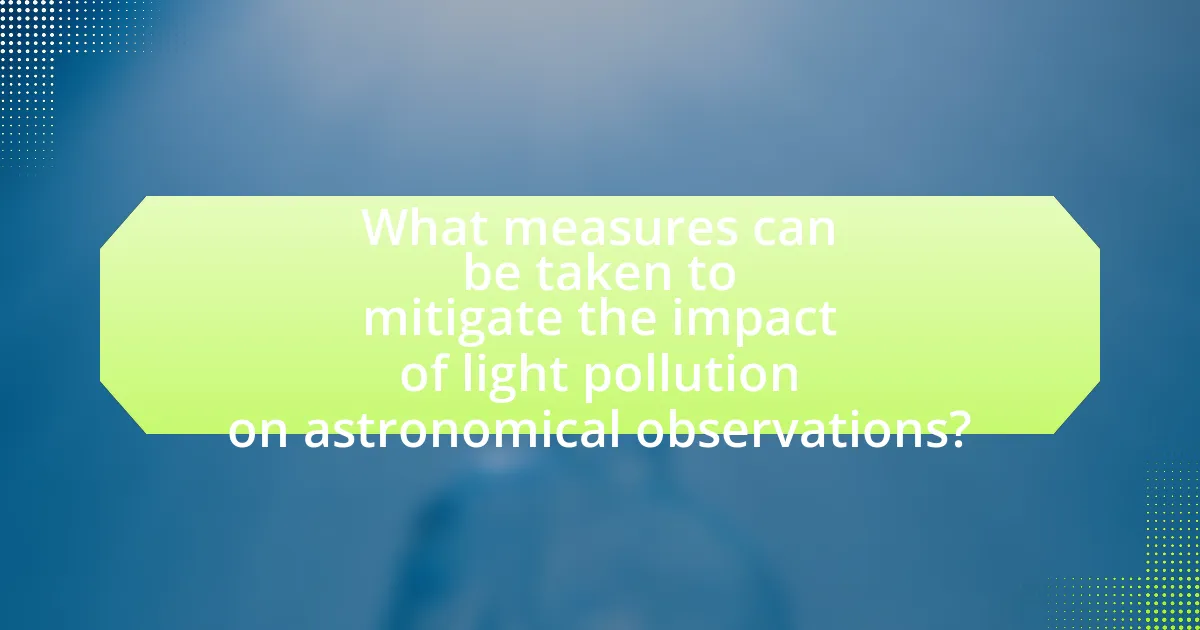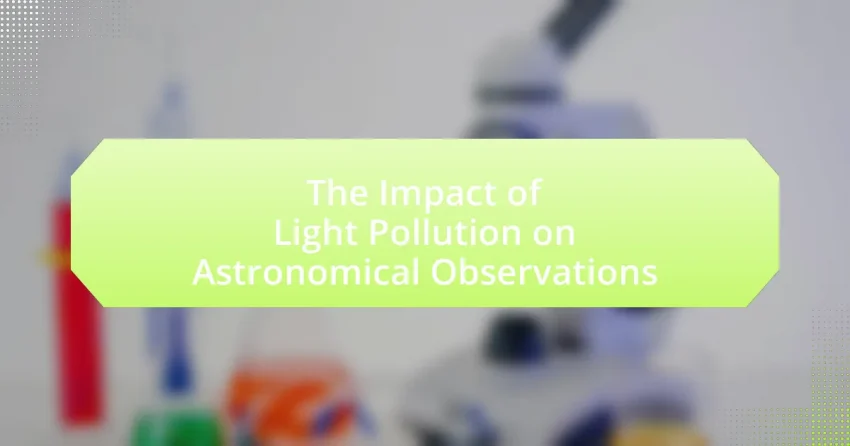Light pollution is a significant barrier to astronomical observations, obscuring celestial objects and diminishing the contrast necessary for detecting faint phenomena such as distant galaxies and nebulae. Urban areas experience a dramatic increase in sky brightness, which can reduce the visibility of stars by up to 90%, severely impacting both professional and amateur astronomers. The article explores the sources of light pollution, its effects on celestial visibility, and the long-term implications for astronomical research. It also discusses potential mitigation strategies, including advancements in lighting technology, community initiatives, and policy changes aimed at preserving dark skies for enhanced observational capabilities.

What is the Impact of Light Pollution on Astronomical Observations?
Light pollution significantly hampers astronomical observations by obscuring celestial objects and reducing the contrast between stars and the night sky. This interference limits the ability of astronomers to detect faint astronomical phenomena, such as distant galaxies and nebulae, which are crucial for understanding the universe. Studies indicate that light pollution can increase the brightness of the night sky by up to 100 times in urban areas compared to rural locations, severely affecting both professional and amateur astronomers. Consequently, many observatories are relocating to darker sites to mitigate these effects and enhance their observational capabilities.
How does light pollution affect the visibility of celestial objects?
Light pollution significantly reduces the visibility of celestial objects by overwhelming the natural light emitted by stars and planets with artificial light sources. This excess artificial illumination creates a bright sky background, making it difficult for observers to distinguish fainter astronomical features. Studies indicate that light pollution can decrease the visibility of stars by up to 90% in urban areas compared to rural locations, where the night sky is darker and more conducive to astronomical observation. The International Dark-Sky Association highlights that this phenomenon not only affects amateur stargazers but also impedes professional astronomical research, as telescopes require dark skies to capture faint light from distant celestial bodies.
What types of celestial objects are most impacted by light pollution?
Celestial objects most impacted by light pollution include faint stars, nebulae, and galaxies. Light pollution obscures the visibility of these objects, making it difficult for astronomers to observe and study them. For instance, studies have shown that light pollution can reduce the visibility of stars by several magnitudes, significantly hindering the ability to detect dim celestial phenomena. This effect is particularly pronounced in urban areas, where artificial lighting overwhelms the natural light from these distant objects, leading to a loss of detail and hindering scientific research.
How does light pollution alter the brightness of stars and planets?
Light pollution significantly reduces the visibility of stars and planets by increasing the background brightness of the night sky. This excess artificial light overwhelms the faint light emitted by celestial objects, making them harder to detect. Studies indicate that in urban areas, the brightness of the night sky can increase by a factor of 100 or more compared to rural locations, severely limiting astronomical observations. For instance, the International Dark-Sky Association reports that over 80% of the world’s population lives under light-polluted skies, which diminishes the ability to observe stars and planets clearly.
Why is light pollution a concern for astronomers?
Light pollution is a concern for astronomers because it obscures celestial objects and interferes with astronomical observations. The excessive artificial light from urban areas creates a bright sky background, making it difficult to detect faint stars, galaxies, and other astronomical phenomena. Studies have shown that light pollution can reduce the visibility of celestial objects by up to 90%, significantly hindering research and discoveries in astronomy. This interference affects both professional observatories and amateur astronomers, limiting their ability to conduct accurate observations and gather data essential for understanding the universe.
What are the long-term effects of light pollution on astronomical research?
Light pollution significantly hinders astronomical research by obscuring celestial objects and reducing the visibility of faint astronomical phenomena. This interference leads to a decrease in the quality of observational data, making it challenging for astronomers to conduct accurate measurements and analyses. Studies indicate that light pollution can diminish the ability to detect distant galaxies and other cosmic structures, as it raises the background brightness against which these objects must be observed. For instance, research published in the journal “Astronomy & Astrophysics” highlights that urban areas experience a reduction in the visibility of stars by up to 90%, severely impacting both professional and amateur astronomers. Consequently, the long-term effects of light pollution include compromised scientific discoveries and a diminished understanding of the universe.
How does light pollution hinder the discovery of new celestial phenomena?
Light pollution significantly hinders the discovery of new celestial phenomena by obscuring faint astronomical objects and reducing the contrast between these objects and the night sky. This interference limits the ability of astronomers to detect and study dim stars, galaxies, and other celestial events, which are crucial for expanding our understanding of the universe. For instance, studies have shown that artificial lighting can increase the brightness of the night sky by up to 100 times in urban areas, making it nearly impossible to observe faint objects that would otherwise be visible in darker environments. Consequently, the prevalence of light pollution directly correlates with a decrease in the number of new discoveries in astronomy, as researchers struggle to identify and analyze phenomena that are obscured by excessive artificial light.

What are the sources of light pollution affecting astronomical observations?
The primary sources of light pollution affecting astronomical observations include streetlights, commercial and residential lighting, billboards, and vehicle headlights. These artificial light sources emit excessive brightness that obscures celestial objects, making it difficult for astronomers to conduct observations. For instance, a study by the International Dark-Sky Association indicates that over 80% of the world’s population lives under light-polluted skies, significantly hindering the visibility of stars and other astronomical phenomena. Additionally, urban areas contribute to skyglow, which is the brightening of the night sky caused by scattered artificial light, further complicating astronomical research.
How do urban areas contribute to light pollution?
Urban areas contribute to light pollution primarily through excessive artificial lighting, which includes streetlights, commercial signage, and residential lighting. This over-illumination creates a bright sky that obscures celestial objects, making it difficult for astronomers to observe stars and other astronomical phenomena. According to a study published in the journal “Science Advances,” artificial light at night has increased by about 2.2% per year globally, significantly impacting the visibility of the night sky in urban settings. The concentration of light sources in cities leads to skyglow, which is a major factor in diminishing the quality of astronomical observations.
What types of artificial lighting are most detrimental to astronomy?
The types of artificial lighting most detrimental to astronomy include streetlights, floodlights, and commercial signage that emit excessive blue light. These light sources contribute significantly to light pollution, which obscures celestial objects and interferes with astronomical observations. Research indicates that blue light, in particular, scatters more in the atmosphere, creating a brighter sky background that diminishes the visibility of stars and other astronomical phenomena. Studies have shown that areas with high-intensity LED streetlights experience a reduction in the ability to observe faint astronomical objects, impacting both professional and amateur astronomers.
How does the design of urban infrastructure exacerbate light pollution?
The design of urban infrastructure exacerbates light pollution primarily through the use of excessive and poorly directed artificial lighting. Urban areas often feature bright streetlights, billboards, and illuminated buildings that contribute to a skyglow effect, which obscures celestial objects. For instance, a study by the International Dark-Sky Association indicates that over 80% of the world’s population lives under light-polluted skies, significantly hindering astronomical observations. Additionally, the placement and intensity of lighting fixtures, such as those on highways and in commercial districts, often lack proper shielding, allowing light to scatter into the atmosphere rather than illuminating intended areas. This design flaw not only increases energy consumption but also disrupts ecosystems and human circadian rhythms, further highlighting the negative impact of urban infrastructure on light pollution.
What role does technology play in light pollution?
Technology significantly contributes to light pollution through the development and widespread use of artificial lighting systems. These systems, including streetlights, commercial signage, and residential lighting, often emit excessive brightness and poorly directed light, which can scatter in the atmosphere. According to a study published in the journal “Science Advances,” artificial light at night has increased by about 2.2% per year globally, leading to detrimental effects on both human health and astronomical observations. This increase in artificial lighting not only obscures celestial bodies but also disrupts ecosystems and wildlife behavior, highlighting the critical role technology plays in exacerbating light pollution.
How can advancements in lighting technology reduce light pollution?
Advancements in lighting technology can significantly reduce light pollution by utilizing energy-efficient LED lights that emit less blue light and are designed to minimize glare. These modern lighting solutions can be directed more precisely, ensuring that light is focused where it is needed, rather than scattering into the night sky. For instance, the adoption of fully shielded fixtures can prevent light from escaping upward, which is a major contributor to skyglow. Studies have shown that implementing such technologies can decrease light pollution levels by up to 50% in urban areas, thereby improving astronomical observations and preserving the natural night environment.
What are the implications of smart city technologies on light pollution levels?
Smart city technologies can significantly reduce light pollution levels through the implementation of adaptive lighting systems and smart controls. These technologies enable cities to adjust street lighting based on real-time data, such as pedestrian presence and traffic flow, thereby minimizing unnecessary illumination during low-traffic periods. For instance, studies have shown that cities employing smart lighting can decrease energy consumption by up to 30%, which directly correlates with reduced light spill and glare. Additionally, smart city initiatives often promote the use of LED lighting, which is more directional and less intrusive than traditional lighting, further mitigating light pollution.

What measures can be taken to mitigate the impact of light pollution on astronomical observations?
To mitigate the impact of light pollution on astronomical observations, implementing shielding for outdoor lighting is essential. This involves using fixtures that direct light downward, reducing skyglow and preserving the visibility of celestial objects. Additionally, adopting regulations for outdoor lighting, such as limiting brightness and using warmer color temperatures, can significantly decrease light pollution. Research indicates that areas with strict lighting ordinances experience improved astronomical visibility, as demonstrated by studies conducted in regions like Flagstaff, Arizona, where light pollution control measures have led to clearer night skies.
How can communities reduce light pollution?
Communities can reduce light pollution by implementing outdoor lighting regulations that promote the use of shielded fixtures and lower-intensity lighting. These regulations can limit excessive brightness and direct light upwards, which contributes to skyglow. Studies indicate that adopting such measures can significantly decrease light pollution levels; for instance, a study by the International Dark-Sky Association found that communities that adopted dark sky ordinances saw a reduction in light pollution by up to 50%. Additionally, encouraging the use of energy-efficient LED lights with appropriate color temperatures can further minimize the impact on nocturnal wildlife and astronomical observations.
What are effective strategies for implementing dark sky initiatives?
Effective strategies for implementing dark sky initiatives include establishing lighting regulations, promoting community awareness, and engaging in partnerships with local governments and organizations. Establishing lighting regulations involves creating and enforcing policies that limit excessive outdoor lighting, which can significantly reduce light pollution. For example, cities like Flagstaff, Arizona, have implemented strict outdoor lighting ordinances that have successfully preserved their night skies. Promoting community awareness through educational programs helps residents understand the benefits of dark skies for both astronomy and wildlife, fostering public support for initiatives. Engaging in partnerships with local governments and organizations can facilitate resource sharing and collaborative efforts, as seen in the International Dark-Sky Association’s work with various municipalities to create dark sky reserves. These strategies collectively contribute to effective dark sky initiatives, enhancing astronomical observations and preserving natural night environments.
How can public awareness campaigns help in reducing light pollution?
Public awareness campaigns can significantly reduce light pollution by educating communities about its negative effects on both the environment and astronomical observations. These campaigns inform the public about the importance of dark skies for stargazing and the detrimental impact of excessive artificial light on wildlife and human health. For instance, studies have shown that light pollution disrupts ecosystems and can lead to a decline in nocturnal species. By raising awareness, campaigns can encourage individuals and local governments to adopt better lighting practices, such as using shielded fixtures and promoting the use of lower-intensity lighting. This shift not only enhances the visibility of celestial bodies but also fosters a collective responsibility towards preserving natural nightscapes.
What are the best practices for astronomers to cope with light pollution?
Astronomers can cope with light pollution by utilizing dark-sky sites, employing specialized filters, and advocating for better lighting regulations. Dark-sky sites, located away from urban areas, provide optimal conditions for astronomical observations by minimizing artificial light interference. Specialized filters can enhance the visibility of celestial objects by blocking specific wavelengths of light commonly emitted by urban lighting. Furthermore, astronomers can engage in advocacy efforts to promote the implementation of lighting regulations that reduce light pollution, such as using shielded fixtures and lower-intensity lighting. These practices collectively help mitigate the adverse effects of light pollution on astronomical research and observations.
What tools and techniques can astronomers use to minimize light pollution effects?
Astronomers can use specialized filters and adaptive optics to minimize the effects of light pollution. Specialized filters, such as narrowband filters, allow astronomers to isolate specific wavelengths of light from celestial objects while blocking out unwanted artificial light. Adaptive optics systems correct for atmospheric distortions, enhancing image clarity and contrast, which is particularly beneficial in light-polluted areas. Additionally, astronomers may choose remote observing sites with minimal light interference or utilize software that processes and reduces light pollution in images, improving the quality of astronomical data collected.
How can astronomers choose optimal locations for observations?
Astronomers can choose optimal locations for observations by selecting sites with minimal light pollution, high altitude, and stable atmospheric conditions. Light pollution significantly hampers the visibility of celestial objects, so astronomers often utilize dark sky areas, such as remote mountains or deserts, where artificial light is minimal. For instance, the Mauna Kea Observatory in Hawaii benefits from its elevation and low humidity, providing clearer skies for astronomical research. Additionally, astronomers analyze weather patterns and atmospheric turbulence to ensure consistent observation conditions, as stable air leads to sharper images.
What are the future trends in addressing light pollution for astronomy?
Future trends in addressing light pollution for astronomy include the development of smart lighting technologies, increased advocacy for dark sky initiatives, and the implementation of stricter regulations on outdoor lighting. Smart lighting systems, which adjust brightness based on real-time conditions, can significantly reduce unnecessary light emissions. Advocacy for dark sky reserves and communities aims to raise awareness and promote practices that minimize light pollution, as evidenced by the International Dark-Sky Association’s efforts to designate over 130 dark sky places worldwide. Additionally, regulations such as the International Commission on Illumination’s guidelines encourage the use of shielded fixtures and lower color temperature lighting, which can mitigate the impact of artificial light on astronomical observations.
How might policy changes impact light pollution regulations?
Policy changes can significantly impact light pollution regulations by introducing stricter standards for outdoor lighting and promoting the use of technologies that minimize light emissions. For instance, legislation aimed at reducing energy consumption often includes provisions for shielding outdoor lights and using lower-intensity lighting, which directly addresses light pollution. Studies have shown that cities implementing such regulations have experienced a reduction in skyglow, thereby improving conditions for astronomical observations. In 2019, a report from the International Dark-Sky Association highlighted that municipalities adopting comprehensive lighting ordinances saw a 30% decrease in light pollution levels over five years, demonstrating the effectiveness of policy changes in regulating light pollution.
What role do international collaborations play in combating light pollution?
International collaborations play a crucial role in combating light pollution by facilitating the sharing of knowledge, resources, and best practices among countries. These partnerships enable the development of standardized guidelines and policies aimed at reducing light pollution, which is essential for preserving dark skies necessary for astronomical observations. For instance, initiatives like the International Dark-Sky Association promote global awareness and provide frameworks for communities to implement effective lighting solutions. Additionally, collaborative research projects, such as those conducted by the European Space Agency, assess the impact of artificial light on ecosystems and human health, further informing strategies to mitigate light pollution.
